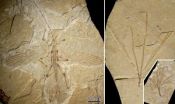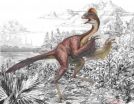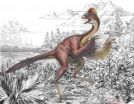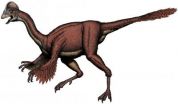(Press-News.org) Heat waves could significantly reduce crop yields and threaten global food supply if climate change is not tackled and reversed.
This is according to a new study led by researchers at the University of East Anglia and published today, 20 March, in IOP Publishing's journal Environmental Research Letters, which has, for the first time, estimated the global effects of extreme temperatures and elevated levels of carbon dioxide (CO2) on the production of maize, wheat and soybean.
Earlier studies have found that climate change is projected to reduce maize yields globally by the end of the century under a "business as usual" scenario for future emissions of greenhouse gases; however, this new study shows that the inclusion of the effects of heat waves, which have not been accounted for in previous modelling calculations, could double the losses of the crop.
Lead author of the study Delphine Deryng, from the Tyndall Centre for Climate Change Research at the University of East Anglia, said: "Instances of extreme temperatures, brought about by a large increase in global mean temperature, can be detrimental to crops at any stage of their development, but in particular around anthesis—the flowering period of the plant.
"At this stage, extreme temperatures can lead to reduced pollen sterility and reduced seed set, greatly reducing the crop yield."
The impacts on wheat and soybean are likely to be less profound, primarily because of the fertilisation effects that elevated levels of CO2 can have on these crops.
In plants, CO2 is central to the process of photosynthesis—the mechanism by which they create food from sunlight, CO2 and water. When there is more CO2 in the atmosphere, the leaves of plants can capture more of it, resulting in an overall increase in the biomass of the plant.
In addition, plants are able to manage their water use much more efficiently in these conditions, resulting in better tolerance to drought episodes. However, it is not clear whether these CO2 fertilisation effects will actually occur in the field owing to interactions with other factors.
If the CO2 fertilisation effects do occur, the researchers found that the yields of wheat and soybean are expected to increase throughout the 21st century under a "business-as-usual" scenario; however, the increases are projected to be significantly offset by the effects of heat waves, as these plants are still vulnerable to the effects of extreme temperatures.
The positive impacts on soybean yield will be offset by 25 per cent and the positive impacts on wheat will be offset by 52 per cent.
The researchers, from the Tyndall Centre for Climate Change Research (University of East Anglia, Norwich), Grantham Research Institute on Climate Change and the Environment (London School of Economics and Political Science, London), and Global Environmental and Climate Change Centre (McGill University, Montreal), arrived at their results using the global crop model PEGASUS to simulate crop yield responses to 72 climate change scenarios spanning the 21st century.
The study also identified particular areas where heat waves are expected to have the largest negative effects on crop yields. Some of the largest affected areas are key for crop production, for example the North American corn belt for maize. When the CO2 fertilisation effects are not taken into account, the researchers found a net decrease in yields in all three crops, intensified by extreme heat stress, for the top-five producing countries of each crop.
"Our results show that maize yields are expected to be negatively affected by climate change, while the impacts on wheat and soybean are generally positive, unless CO2 fertilisation effects have been overestimated," continued Deryng.
"However, extreme heat stress reinforced by 'business-as-usual' reduces the beneficial effects considerably in these two crops. Climate mitigation policy would help reduce risks of serious negative impacts on maize worldwide and reduce risks of extreme heat stress that threaten global crop production."
INFORMATION:
From Thursday 20 March, this paper can be downloaded from http://iopscience.iop.org/1748-9326/9/3/034011/article
Notes to Editors
Contact
For further information, a full draft of the journal paper or contact with one of the researchers, contact IOP Press Officer, Michael Bishop: Tel: 0117 930 1032 E-mail: michael.bishop@iop.org For more information on how to use the embargoed material above, please refer to our embargo policy.
IOP Publishing Journalist Area
The IOP Publishing Journalist Area gives journalists access to embargoed press releases, advanced copies of papers, supplementary images and videos. In addition to this, a weekly news digest is uploaded into the Journalist Area every Friday, highlighting a selection of newsworthy papers set to be published in the following week. Login details also give free access to IOPscience, IOP Publishing's journal platform. To apply for a free subscription to this service, please email Michael Bishop, IOP Press Officer, michael.bishop@iop.org, with your name, organisation, address and a preferred username.
Global crop yield response to extreme heat stress under multiple climate change futures
The published version of the paper 'Global crop yield response to extreme heat stress under multiple climate change futures' (Delphine Deryng, Declan Conway, Navin Ramankutty, Jeff Price and Rachel Warren 2014 Environ. Res. Lett. 9 034011) will be freely available online from 20 March. It will be available at http://iopscience.iop.org/1748-9326/9/3/034011/article.
Environmental Research Letters
Environmental Research Letters is an open access journal that covers all of environmental science, providing a coherent and integrated approach including research articles, perspectives and editorials.
IOP Publishing
IOP Publishing provides a range of journals, magazines, websites and services that enable researchers and research organisations to reach the widest possible audience for their research. We combine the culture of a learned society with global reach and highly efficient and effective publishing systems and processes. With offices in the UK, US, Germany, China and Japan, and staff in many other locations including Mexico and Russia, we serve researchers in the physical and related sciences in all parts of the world. IOP Publishing is a wholly owned subsidiary of the Institute of Physics. The Institute is a leading scientific society promoting physics and bringing physicists together for the benefit of all. Any profits generated by IOP Publishing are used by the Institute to support science and scientists in both the developed and developing world. Go to ioppublishing.org.
Access to Research
Access to Research is an initiative through which the UK public can gain free, walk-in access to a wide range of academic articles and research at their local library. This article is freely available through this initiative. For more information, go to http://www.accesstoresearch.org.uk
The Institute of Physics
The Institute of Physics is a leading scientific society. We are a charitable organisation with a worldwide membership of more than 50,000, working together to advance physics education, research and application. We engage with policymakers and the general public to develop awareness and understanding of the value of physics and, through IOP Publishing, we are world leaders in professional scientific communications. Go to http://www.iop.org.
Future heat waves pose threat to global food supply
2014-03-20
ELSE PRESS RELEASES FROM THIS DATE:
Data on antibiotic use in non-EU countries should stimulate development of action plans
2014-03-20
A new study, published in The Lancet Infectious Diseases journal, provides the first ever reliable data on antibiotic use in non-European Union (EU) southern and eastern European countries and newly independent states.
The research, which was led by Dr Herman Goossens, of the Vaccine and Infectious Disease Institute (VAXINFECTIO) at the University of Antwerp, Belgium, is a critical first step in identifying targets for improvements in the way antibiotics are used in these countries. The authors hope that the findings will aid the development of national action plans ...
Fossils of earliest stick insect to mimic plants discovered
2014-03-19
An ancient stick insect species may have mimicked plant leaves for defense, according to a paper published in the open-access journal PLOS ONE on March 19, 2014 by Maomin Wang, from Capital Normal University, China and colleagues.
Many insects have developed defense mechanisms, including the ability to mimic the surrounding environment. Stick and leaf insects mimic plants from their environment, but scientists know little about the original of this interaction due to little or no previous stick insect fossil records showing this adaptation. The scientists discovered three ...
Large feathered dinosaur species discovered in North America
2014-03-19
Fossils found in western North America reveal a new species of large-bodied, feathered oviraptorosaurian theropod dinosaur from the latest Cretaceous Period, according to a paper published in the open-access journal PLOS ONE on March 19, 2014 by Matthew Lamanna from Carnegie Museum of Natural History in Pennsylvania and colleagues.
Known for their beaks, long necks, and relatively short tails, the bird-like oviraptorosaurian group contains dinosaurs with body sizes ranging from a few kilograms to more than one metric ton. The scientists described three well-preserved partial ...
Fossilized bighorn sheep poop reveals early Holocene population
2014-03-19
Genetic analysis of ancient poop found off the coast of Mexico suggests bighorn sheep may be native to the island, according to a paper published in the open-access journal PLOS ONE on March 19, 2014 by Benjamin Wilder from University of California Riverside and colleagues.
Bighorn sheep were not thought to inhabit Tiburón Island, the largest island in the Gulf of California and Mexico, prior to their introduction in 1975. Scientists discovered fossilized dung in the mountains of Tiburón Island that challenges that assumption. Scientists compared the pellet-shaped poop ...
Bighorn sheep went extinct on desert island in Gulf of California, study finds
2014-03-19
RIVERSIDE, Calif. — Using ancient DNA analysis and other techniques, a research team led by conservation biologists at the University of California, Riverside has determined that bighorn sheep, so named for their massive spiral horns, became extinct on Tiburón Island, a large and mostly uninhabited island just off Sonora, Mexico, in the Gulf of California, sometime in the last millennium — specifically between the 6th and 19th centuries.
The result, published March 19 in PLOS ONE, is a surprise because conventional wisdom among wildlife biologists and the indigenous Seri ...
A 'chicken from hell' dinosaur
2014-03-19
SALT LAKE CITY, March 19, 2014 – Scientists from Carnegie and Smithsonian museums and the University of Utah today unveiled the discovery, naming and description of a sharp-clawed, 500-pound, bird-like dinosaur that roamed the Dakotas with T. rex 66 million years ago and looked like an 11 ½-foot-long "chicken from hell."
"It was a giant raptor, but with a chicken-like head and presumably feathers. The animal stood about 10 feet tall, so it would be scary as well as absurd to encounter," says University of Utah biology postdoctoral fellow Emma Schachner, a co-author of ...
Smithsonian collaborates with paleontologist team to reveal new large, feathered dinosaur
2014-03-19
A team of scientists from the Smithsonian's National Museum of Natural History, the Carnegie Museum of Natural History and the University of Utah has described an unusual bird-like dinosaur previously unknown to science, resembling a cross between a modern emu and a reptile. The new species, Anzu wyliei, lived 68 to 66 million years ago and was identified from three partial skeletons collected from the Upper Cretaceous Hell Creek Formation in North and South Dakota. The species belongs to Oviraptorosauria, a group of dinosaurs mostly known from fossils found in Central ...
Paleontologists announce discovery of Anzu wyliei
2014-03-19
Pittsburgh, Pennsylvania…A team of researchers has announced the discovery of a bizarre, bird-like dinosaur, named Anzu wyliei, that provides paleontologists with their first good look at a dinosaur group that has been shrouded in mystery for almost a century. Anzu was described from three specimens that collectively preserve almost the entire skeleton, giving scientists a remarkable opportunity to study the anatomy and evolutionary relationships of Caenagnathidae (pronounced SEE-nuh-NAY-thih-DAY)—the long-mysterious group of theropod dinosaurs to which Anzu belongs. The ...
High-frequency breathing support for premature babies could lead to better lung function
2014-03-19
A new study led by researchers at King's College London has found that premature babies supported immediately after birth by high-frequency oscillation - a type of breathing support - had better lung function as adolescents than those who received conventional ventilation. The children ventilated with the high frequency method also showed higher academic achievement in three of eight school subjects.
The findings of the research, funded by the National Institute for Health Research (NIHR) Health Technology Assessment (HTA) Programme and the NIHR Biomedical Research Centre ...
Studies advance potential use Of MRI magnetic fields to treat balance disorders
2014-03-19
Expanding on earlier research, Johns Hopkins researchers report that people with balance disorders or dizziness traceable to an inner-ear disturbance show distinctive abnormal eye movements when the affected ear is exposed to the strong pull of an MRI's magnetic field.
The researchers first reported in 2011 in the journal Current Biology that an MRI's magnetic field pushes on the inner ear fluid responsible for maintaining balance, causing subjects undergoing MRI scans to have jerky eye movements and dizziness.
Two new studies now suggest that these strong magnets could ...





